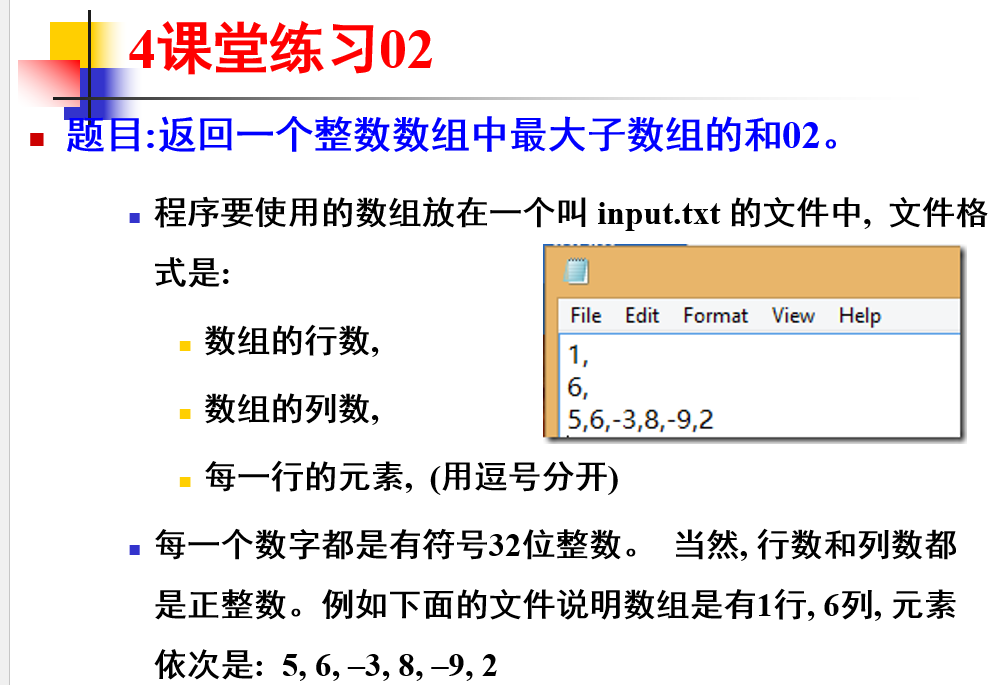课堂练习——返回一个整数数组中最大的子数组的和
第一阶段:

主要难点在于如何把时间复杂度控制在O(n),当时想了很久都没想明白,这是听了同学的思路之后按照他的思路进行编程的。整体来说难点不大,具体代码 如下:
import java.util.Scanner; /** * @author migua * @version 1.0 * @date 2022/3/11 9:44 */ public class aa { public static void main(String[] args) { System.out.println("数组长度"); Scanner sc = new Scanner(System.in); int l = sc.nextInt(); int[] arrNum = new int[l]; System.out.println("数组的值"); for (int i = 0; i < l; i++) { int x = sc.nextInt(); if(x < 2147483647 || x > -2147483648 ) arrNum[i] = x; else { System.out.println("数据输入超界,程序已退出"); return; } //System.out.println(arrNum[i]); } int[] arrRes = new int[l]; for(int i = 0;i<arrNum.length;i++) { arrRes[i]=0; } int i = 0,j=0; int max = 0; for (i = 0; i < l; i++) { //j为当前子数组的开头下标 if(i == 0) { arrRes[i]=arrNum[0]; //System.out.println("初始arrRes值为:" + arrRes[i]); } else if(i > 0) { int pre = arrRes[i - 1]; int now = arrNum[i] + arrRes[i - 1]; if(pre < 0) { arrRes[i]=arrNum[i]; } else if (pre < now) { arrRes[i] = now; //System.out.println("arrRes[i]" + arrRes[i]); } else { j=i; arrRes[i] = arrNum[i]; } } } max=arrRes[0]; for( i = 0;i <arrRes.length;i++) { if(arrRes[i]>max && arrRes[i] <2147483647) max=arrRes[i]; else if(arrRes[i] >= 2147483647 || arrRes[i] < -2147483648) { System.out.println("数据溢出,程序已退出"); return ; } } System.out.println(max); } }
运行截图:

第二阶段:

注意点:
(1)通过Scanner、相对路径来读取文件
(2)scanner.hasNextLine()函数读取下边对应行的内容
(3) 对应较大的数据时,简单的判断会非常地麻烦。从朝勇那里听到BigDecimal,然后就去学了一下,真的好用,所有问题直接迎刃而解。
代码如下:
/** * @author migua * @version 1.0 * @date 2022/3/11 19:25 */ import java.io.*; import java.math.BigDecimal; import java.util.List; import java.util.Scanner; public class bb { public static void main(String[] args) { try { Scanner scanner = new Scanner(new FileReader("src/test.txt")); int row = 0; int column = 0; int tempRow, tempColumn; for (int i = 0; i < 2 && scanner.hasNextLine(); i++) { String L = scanner.nextLine(); if (i == 0) { row = Integer.parseInt(L.substring(0, L.indexOf(','))); } else { column = Integer.parseInt(L.substring(0, L.indexOf(','))); } } if (row <= 0 || column <= 0) { System.out.println("行数或者列数出错"); return; } int tempInt[] = new int[row * column]; int tempIndex = 0; for(tempRow =0;tempRow<row &&scanner.hasNextLine();tempRow++) { //不存在下一行或者已经读完该读的行 String L = scanner.nextLine(); for (tempColumn = 0; tempColumn < column - 1 && !L.equals(""); tempColumn++) { tempInt[tempIndex++] = Integer.parseInt(L.substring(0, L.indexOf(','))); //先获取从头开始至第一个逗号之间的数 L = L.substring(L.indexOf(',') + 1, L.length()); //将第一个逗号之后的值覆盖原来的值 } if (!L.equals("")) { tempInt[tempIndex++] = Integer.parseInt(L.substring(0)); tempColumn++; } if (tempColumn != column) { System.out.println("数据的列数不对"); return; } } if (tempRow != row || scanner.hasNextLine()) { System.out.println("数据的行数不对"); return; } BigDecimal max = new BigDecimal("0"); BigDecimal tempMax = new BigDecimal("0"); for (int i = 0; i < row * column; i++) { if (i == 0) { BigDecimal temp = new BigDecimal(tempInt[i]); tempMax=tempMax.add(temp); max=max.add(temp); //max = tempInt[i]; } else { if (tempMax.compareTo(new BigDecimal("0")) == -1) //tempMax < 0 { tempMax = new BigDecimal(tempInt[i]); } else { tempMax=tempMax.add(new BigDecimal(tempInt[i])); } } if (tempMax.compareTo(max) == 1) //tempMax > max { max = tempMax; } } System.out.println(max); } catch(FileNotFoundException e){ e.printStackTrace(); } } }
代码运行截图:






